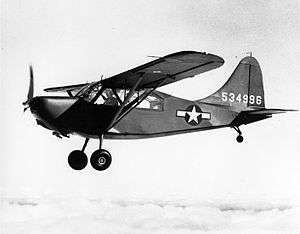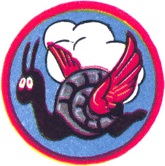47th Liaison Squadron
The 47th Liaison Squadron is an inactive United States Air Force unit. Its last assignment was with Tactical Air Command at Langley Air Force Base, Virginia, where it was inactivated on 25 August 1948. The squadron was activated in July 1943. It trained in the United States until the spring of 1944, then deployed to the European Theater of Operations. It served as a courier and communication unit for various headquarters. After V-E Day, it remained in Germany as part of the occupation force until 1947, when it returned to the United States as a paper unit. It remained in that status until inactivating.
| 47th Liaison Squadron | |
|---|---|
 L-5 Sentinel as flown by the squadron | |
| Active | 1943–1948 |
| Country | |
| Branch | |
| Role | Courier |
| Engagements | European Theater of Operations |
| Insignia | |
| 47th Liaison Squadron emblem (approved 19 January 1944)[1] |  |
History
The 47th Liaison Squadron was activated at Gainesville Army Air Field, Texas on 1 July 1943 as one of the four squadrons of the 426th Reconnaissance Group. The following month the squadron was reassigned to II Air Support Command, as the 426th Group was inactivated without fully equipping or being brought up to strength.[2] The squadron was equipped with a variety of light aircraft, primarily Stinson L-5 Sentinels and Piper L-4 Grasshoppers, but it also flew a few Stinson L-1 Vigilants and Taylorcraft L-2 Grasshoppers. The 47th trained at bases in Texas and Louisiana until late March 1944, when it departed for the European Theater of Operations.[1] Squadron training was informal and extended due to the absence of a formal training program until January 1944 and the absence of a definition of the squadron's mission. Because the squadron was nearing its overseas deployment, it received little benefit from the formal training program.[3]
After its arrival at Cheltenham, England in early April 1944, the squadron moved to RAF Heston. It provided courier service for Headquarters Command, European Theater of Operations, U.S. Army until after D-Day, primarily with L-5 Sentinels.[1] Other squadron missions included transport of personnel, aeromedical evacuation, visual reconnaissance, providing commanders with information to control advancing columns and checking passive air defense measures.[3] In late July, it moved one flight to the European continent, flying from Colombieres Airfield, France to support First Army Group. The squadron followed in August, when it moved to Saint-Sauveur-Lendelin. For the remainder of the war, it was attached to Twelfth Army Group.[1]
Just before V-E Day, the squadron moved to Wiesbaden Air Base, Germany where it became part of the occupation forces. After August 1945, it was attached to attached to Headquarters Command, European Command and supported that headquarters until May 1947.[1]
The squadron became non-operational and was moved to Langley Field, Virginia in June 1947. The squadron was not manned or equipped at Langley, and was finally inactivated on 25 August 1948.[1]
Lineage
- Constituted as the 47th Liaison Squadron on 25 June 1943
- Activated on 1 July 1943
- Inactivated on 25 August 1948[1]
Assignments
- 426th Reconnaissance Group, 1 July 1943
- II Air Support Command (later II Tactical Air Division), 11 August 1943
- United States Strategic Air Forces in Europe, 4 April 1944 (attached to Headquarters Command, European Theater of Operations, United States Army, until 17 April 1944; then First Army Group until 9 August 1944; then to Twelfth Army Group)
- Ninth Air Force, 25 April 1944 (attached to Twelfth Army Group, until 1 August 1945; then to Headquarters Command, US Forces, European Theater)
- XII Tactical Air Command, 23 November 1945 (attached to Headquarters Command, US Forces, European Theater (later Headquarters Command, United States European Command))
- 70th Fighter Wing, 1 February 1946 (attached to Headquarters Command, European Command)
- 64th Fighter Wing, 4 March 1946 (attached to Headquarters Command, European Command)
- XII Tactical Air Command, 1 May 1947 (attached to Headquarters Command, European Command until 31 May 1947)
- Tactical Air Command, 25 June 1947 – 25 August 1948[1]
Stations
|
|
Aircraft
- Stinson L-5 Sentinel, 1943-1947
- Piper L-4 Grasshopper, 1943-1944
- Stinson L-1 Vigilant, 1943-1944
- Taylorcraft L-2 Grasshopper, 1943-1944[1]
Campaigns
| Campaign Streamer | Campaign | Dates | Notes |
|---|---|---|---|
| Northern France | 25 July 1944–14 September 1944 | [1] | |
| Rhineland | 15 September 1944–21 March 1945 | [1] | |
| Ardennes-Alsace | 16 December 1944–25 January 1945 | [1] | |
| Central Europe | 22 March 1944–21 May 1945 | [1] | |
| World War II Army of Occupation (Germany) | 9 May 1945–25 June 1947 | [1] |
References
Notes
- Maurer, Combat Squadrons, p. 207
- Maurer, Combat Units, pp. 302-303
- Gray (unpaginated)
- Station number in Anderson.
- Station number in Johnson.
- Station information in Maurer, Combat Squadrons, p. 207, except as noted.
Bibliography
![]()
- Anderson, Capt. Barry (1985). Army Air Forces Stations: A Guide to the Stations Where U.S. Army Air Forces Personnel Served in the United Kingdom During World War II (PDF). Maxwell AFB, AL: Research Division, USAF Historical Research Center. Archived from the original (PDF) on 23 January 2016. Retrieved 28 June 2017.
- Gray, Jim, The Army Air Forces Liaison Squadrons of World War II, Stinson Owners & Pilots Association
- Johnson, 1st Lt. David C. (1988). U.S. Army Air Forces Continental Airfields (ETO) D-Day to V-E Day (PDF). Maxwell AFB, AL: Research Division, USAF Historical Research Center. Archived from the original (PDF) on 29 September 2015. Retrieved 26 June 2017.
- Maurer, Maurer, ed. (1983) [1961]. Air Force Combat Units of World War II (PDF) (reprint ed.). Washington, DC: Office of Air Force History. ISBN 0-912799-02-1. LCCN 61060979. Retrieved 17 December 2016.
- Maurer, Maurer, ed. (1982) [1969]. Combat Squadrons of the Air Force, World War II (PDF) (reprint ed.). Washington, DC: Office of Air Force History. ISBN 0-405-12194-6.
.svg.png)